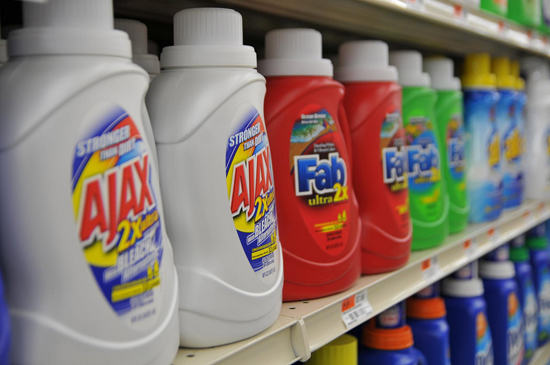The trend away from toxic chemicals is clear: Growing market demand and government regulations are pushing companies to move away from chemicals of high concern to human health or the environment.
Johnson & Johnson, Procter & Gamble, Walmart and Target are among the companies that recently have announced policies to eliminate chemicals of high concern from their products and supply chains.
Are the alternatives safer?
Chemical alternatives assessment is an emerging field of practice that works to substitute chemicals of high concern with safer alternatives. Embedded into the new California Safer Consumer Product Regulations, which went into effect Oct. 1, alternatives assessment holds the promise of rapidly phasing out chemicals of high concern by replacing them with safer alternatives or avoiding their need in the first place.
California is embarking on a process of identifying chemicals of concern in products, evaluating safer alternatives to those chemical-product combinations, based on assessments done by businesses, and implementing regulations when needed to reduce exposure to hazardous chemical-product combinations. The Safer Consumer Product Regulations establish a two-stage alternatives analysis process that guides companies through steps to evaluate alternatives. The goal is safer alternatives and no regrettable substitutions.
How will companies comply with the California Safer Consumer Products regulations? What does an alternatives analysis that complies with the law look like? BizNGO, a collaboration of business and nonprofits, set out to answer this question.
We selected chemical-product combinations that could be of interest to the State of California: nonylphenol ethoxylates (NPE) in all-purpose cleaners and decabromodiphenyl ether (decaBDE) in external computer housings.
Both these assessments have the advantage of drawing from abundant information on alternatives, including hazard assessments on the alternative chemistries. Below we detail our draft assessments, recently released for public comment.
Walmart and Target are among the retailers that have vowed to phase out toxic materials from the products they sell.Retailers Walmart and Target are among the retailers that have vowed to phase out toxic materials from the products they sell.

Retailers Walmart and Target are among the retailers that have vowed to phase out toxic materials from the products they sell.
Toxic cleaning chemicals
NPE in all-purpose cleaners are of concern because of toxicity to aquatic organisms. When the chemical enters waterways, it is slow to degrade and toxic to water life. BizNGO's preliminary assessment on NPE alternatives for all-purpose cleaners finds that functionally equivalent, cost-competitive and safer alternatives are widely available to NPE. The U.S. Environmental Protection Agency, for example, lists four NPE alternatives on its Safer Chemical Ingredients List. Our preliminary NPE assessment also indicates the challenges of comprehensive alternatives assessments.
On the hazard assessment side (Stage 1 of the California Regulations), we found many data gaps for the NPE alternatives, which mirrors the reality that very few chemicals have comprehensive toxicological data sets. On the life cycle impacts side (Stage 2 of the California regulations), the NPE assessment did not identify any new hot spot issues for NPE alternatives, beyond known existing concerns for NPE. While we found some life cycle inventory data for NPE alternatives, we did not find life cycle data that directly would plug into meeting the California requirements for multimedia life cycle impacts.
Safer alternatives to toxic flame retardants in computers
The second chemical we evaluated was decaBDE in external computer housings. It is a chemical of concern because of exposure to residents of houses and offices, and due to the release of toxic breakdown products if the computer housings are burned at the end of their life.
BizNGO's preliminary assessment on decaBDE alternatives in external computer housings finds that functionally equivalent, cost-competitive and safer alternatives are widely available as well. On the hazard assessment side (Stage 1 of California regulations), the BizNGO decaBDE assessment finds many safer alternatives. These findings are consistent with the U.S. EPA's recent decaBDE alternatives assessment report. On the life cycle impacts side (Stage 2 of the California regulations), the decaBDE assessment identified raw materials extraction as a potential increased impact due to the relative ease of extracting bromine — a core feedstock of decaBDE — from the Earth.
Yet, in terms of the overall product profile, flame retardant choice has a minuscule impact on a computer's life cycle profile. Similar to the NPE assessment, no perfect plug in life cycle data were found for decaBDE in computer housings.
The power of alternatives assessment
The BizNGO assessments found economically viable alternatives to be clearly available to both NPE in all-purpose cleaners and decaBDE in computer housings. But BizNGO struggled with finding data that would comply with the California economic impact analysis requirements of assessing both public health costs and costs to government agencies related to the alternatives. In general, we did not anticipate any additional costs associated with alternatives, but lacked definitive data to support that.
The BizNGO chemical alternative assessments indicate both the challenges with and power of alternatives assessment. A key challenge is that the sheer scope of data requirements can lead to "paralysis by analysis" because there are no perfect data sets or alternatives that are better on every attribute than the existing chemical of concern. Alternatives assessment could lead to a situation where the perfect is the enemy of the good. On the upside, chemical alternatives assessment, especially hazard assessments, can identify alternatives clearly preferable to human health and the environment that also meet cost and performance requirements.
BizNGO welcomes feedback on the NPE and decaBDE assessments (go to bizngo.org). In seeking comments, BizNGO wants to know how others see the process of alternatives assessment. Is BizNGO's interpretation of alternatives assessment in general and the regulations in particular consistent with how others approach alternatives assessment? BizNGO believes that alternatives assessments, if done correctly, will lead society away from chemicals of concern to human health or the environment to safer alternatives.


